Book contents
- Frontmatter
- Contents
- Acknowledgements
- List of abbreviations
- 1 Introduction
- 2 The 1610 settings and the liturgy of Vespers
- 3 The 1610 print and Monteverdi's career
- 4 ‘Suited to the chapels or chambers of princes’
- 5 ‘And all on a cantus firmus’
- 6 Issues of performance
- Appendices
- Notes
- Select bibliography
- Discography
- Index
4 - ‘Suited to the chapels or chambers of princes’
Published online by Cambridge University Press: 12 January 2010
- Frontmatter
- Contents
- Acknowledgements
- List of abbreviations
- 1 Introduction
- 2 The 1610 settings and the liturgy of Vespers
- 3 The 1610 print and Monteverdi's career
- 4 ‘Suited to the chapels or chambers of princes’
- 5 ‘And all on a cantus firmus’
- 6 Issues of performance
- Appendices
- Notes
- Select bibliography
- Discography
- Index
Summary
Monteverdi's comment that the Vespers settings and sacred concertos were ‘suited to the chapels or chambers of princes’ indicates that he expected his music to be performed by the expert singers and instrumentalists employed at a court like Mantua or at major churches like St Peter's, Rome, or St Mark's, Venice, or perhaps in one of the musical establishments presided over by a cardinal. And since court and Church were the major employers of professional musicians in the late Renaissance, such establishments would have included the finest performers of the day. The sacred concertos of the 1610 print were certainly designed to show off the accomplishments of such performers, and the styles and techniques that they exemplify range from wellestablished traditions of vocal and instrumental virtuosity to the most up-to-date rhetorical styles of Florentine continuo song and opera.
Virtuoso singers were highly prized in court circles, the best of them receiving much higher payment than the composers who supplied them with music. Unlike the star singers of today, however, whose voices are trained to produce a rich, dark, powerful tone that can be projected over a large orchestra, virtuosos of Monteverdi's day cultivated lighter and more flexible voices with the ability to articulate notes very rapidly in the throat. This last ability was particularly important since they were expected, especially when singing solo, to grace the lines that they sang with ornate and technically difficult improvised ornamentation; and their ability to do this was one of the most admired aspects of their art.
- Type
- Chapter
- Information
- Monteverdi: Vespers (1610) , pp. 41 - 59Publisher: Cambridge University PressPrint publication year: 1997



